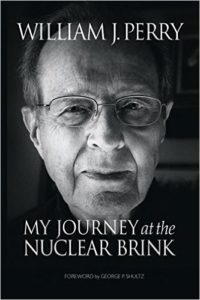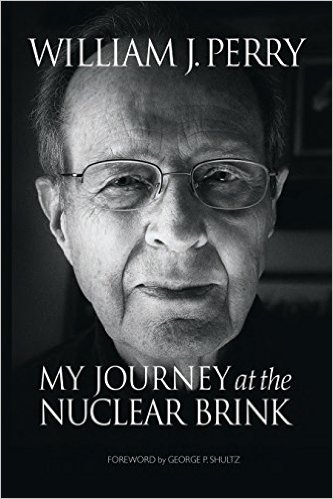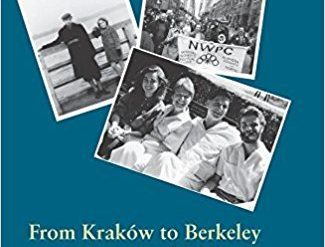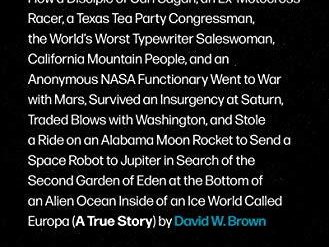
At times it seems as though about a dozen people run the federal government. They change jobs from one administration to the next, occasionally drop out to work in academia or industry for a time, but then pop up again when another President comes along. At their level — the cabinet and sub-cabinet positions — political party tends not to matter as much as the public might think. History is full of such examples. One of those people is William J. Perry, who worked in a succession of posts involved in addressing the enduring nuclear threat.
Six decades combating the nuclear menace
Now 88 years of age, Perry is best known as the former Deputy Secretary and then Secretary of Defense under Bill Clinton, but his career in government — and in a variety of private-sector positions elsewhere in the military-industrial complex — began in the 1950s. In My Journey at the Nuclear Brink, Perry ably recounts his efforts over six decades to combat the menace of nuclear weapons from his positions in government, private industry, academia, and, now, the nonprofit sector. His account is brisk, readable, and ultimately terrifying.
My Journey at the Nuclear Brink by William J. Perry (2015) 278 pages ★★★★☆
The enduring nuclear threat
Perry makes his case at the outset: “Nuclear weapons no longer provide for our security — they now endanger it.” Because of the failure of the U.S. and Soviet governments to reach agreement on eliminating nuclear weapons entirely, a step that was within their reach three decades ago, and the proliferation of nuclear technology to at least seven other nations, the human race is if anything more at risk from nuclear bombs than we were at the height of the Cold War, with the sole exception of the Cuban Missile Crisis. According to the Stockholm International Peace Research Institute, the United States, Russia, United Kingdom, France, China, India, Pakistan, Israel, and North Korea collectively possess a total of more than 16,000 nuclear weapons. A single missile, with ten nuclear warheads, could obliterate all the major capital cities of Europe — or the ten biggest cities in the United States.
Perry foresees three principal threats: the increasingly bellicose stance of Russia under Vladimir Putin, the ever-present possibility of a nuclear war between India and Pakistan, and the possibility that terrorists might steal or purchase a weapon and detonate it in a large American city.
A chilling history of nuclear confrontation
Perry’s memoir brings to light several little-known events and circumstances that might have led to a full-blown nuclear conflagration between the U.S. and the USSR. “Although the Cuban Missile Crisis [in October 1962] ended without war,” he writes, “I believed then, and still believe, that the world avoided a nuclear holocaust as much by good luck as by good management. . . For example, we now know that the Soviet ships approaching our blockade of Cuba had submarine escorts, and that the Soviet submarines were armed with nuclear torpedoes . . . [T]he commanders had been given the authority to fire [those] torpedoes without authorization from Moscow.
“Only years after the crisis did we learn that one of the Soviet commanders had seriously considered firing one . . . at an American destroyer that was trying to force him to surface. He was dissuaded from doing so only by the other officers on the submarine.” This is scary stuff. Very scary. At the time I was terrified. Yet I didn’t understand just how close we came to Armageddon.
Perry makes clear that politics rather than military necessity has dictated the massive expansion of our nuclear forces in the past and prevents its further reduction today. “I can testify,” he writes, “that during the Cold War, no US president was willing to accept nuclear forces smaller than those of the Soviet Union” even though both nations had armed enough missiles to reduce the planet to ashes many times over. It was this imbalance that powered the nuclear arms race rather than the need for deterrence. In fact, the Triad — our nuclear forces on land, in the air, and under the sea — is unnecessary. “I am convinced that we could have confidence in our deterrence if we had only submarine-based missiles.”
A front seat at the brink
In his memoir, Perry recounts the various ways in which he personally has been involved in holding back the nuclear threat. In the 1950s and 60s, as a research scientist, he helped to develop the reconnaissance technology that revealed the true extent of the Soviet Union’s nuclear forces (undermining the fantasy of the “nuclear gap” that politicians — including John F. Kennedy — used to frighten the American people). In the 1970s, as a senior Defense Department official, he helped engineer the development of the U.S. deterrent that (in theory) prevented a Soviet attack.
Then, in the 1990s, in collaboration with Senators Sam Nunn and Richard Lugar, he implemented the U.S. program to remove nuclear weapons and nuclear materials from Ukraine, Kazakhstan, and Belarus. Now, in the 21st century, he is working through the nonprofit sector with other former federal heavyweights (George Schultz, Henry Kissinger, and Sam Nunn) to campaign for nuclear nonproliferation and for reforms in the nuclear alert system that he believes to be antiquated and dangerous.
For related reading
This book is one of Two dozen excellent memoirs. This is also one of the many good nonfiction books about national security.
You might also enjoy Great biographies I’ve reviewed: my 10 favorites.
Like to read books about politics and current affairs? Check out Top 10 nonfiction books about politics.
And you can always find my most popular reviews, and the most recent ones, on the Home Page.



























